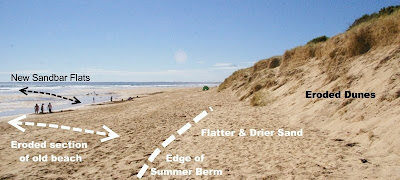Over the next three days as we approach the full moon the tides at Venus bay are predicted to be at the highest and lowest with a 18.6 year cycle. Coresponding when the moon and sun being in direct mutual alignment and at there closest points to earth. This can occur on either a new moon or a full moon. (there is a reply in this forum that explains this in more detail)
Probably the most interesting place to make observations will be at low tide. When the recents movement of sand should form interesting ruts and pools.
Tuesday, September 1, 2009
Tuesday, June 9, 2009
Wind Erosion
There are two types of wind erosion
1)By Deflation, the wind picks up oarticles of fine grained sand and/or dust, moves and then deposites them elsewhere.
2)By Abrasion, the sandblasting like effect of windblown sand.
Onshore winds can lift sand from the beach and replenish the dunes behind the beach, but not today. Yet more sand is moving southwards along the beach.
Thursday, May 21, 2009
Toxic Chemical Drums
Several drums of a toxic chemical, possibly a concentrated industrial cleaner. have washed ashore at beaches to the west of Venus Bay. The EPA warn that the drums should be left alone (and presumably reported), eleven people have already reported to hospitals after coming in contact with the drums.
Sunday, January 11, 2009
The new beach profile

Taken at 4:25pm (approx 2 hours before "official" low tide) on 11/1/2009 atmospheric pressure was 1012 hPa
The low tides at the moment seem exceptionally low for three reasons
1. The 18.6 year maximum tide cycle (its related to the full moon)
2. High atmospheric pressure ( lowers the sea level)
3. the beach profile has change. (little of no summer berm developed and lowering of the beach generally)
The above photo shows how different the beach profile is this year. The erosion scars at the back of the beach are "healing", the front faces have mainly collapsing and are forming a more even rill, The dry sand is being carried by the wind, eroding a smooth slope in some places and depositing and riling down in others. In front of this in only a few places a narrow summer berm is developing. This is the area mainly above high tide where the beach can dry out and wind erosion take over as the main erosion agent. The wind flattens out this zone to almost horizontal (which is why it is called a berm) When it develops a distinct bump can be seen, where the gradient of the beach changes. In previous years this summer berm may have reach 10-30m wide by mid January. Now it is only present in a few places and seldom wider than 3m. The beach in front of that still have the steep gradient more characteristic of winter and the old beach profile has been clearly lowered (much sand eroded away). In front of that there are extensive flatter areas of sandbank being developed. This sand is frequently soft (unconsolidated) because it is being moved back and forth a lot with each tide). Extensive rutting, guttering and ripple pools are being developed and then wash away in the next tide or their position and form changing daily. The beach is reaching width of 100m to 150m from dune to water edge at low tide.
Labels:
atmospheric pressure,
beach,
low,
profile,
summer berm,
tides
Subscribe to:
Comments (Atom)
